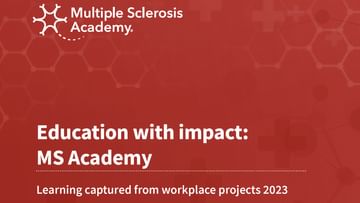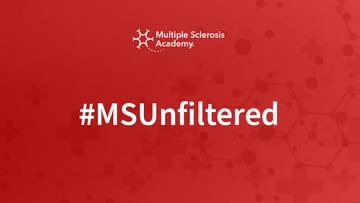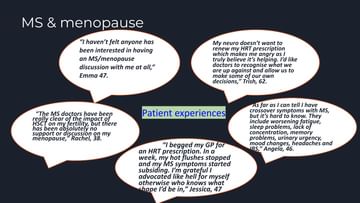MS Variance: The ‘co-ordinated multidisciplinary team meeting’ and what that term really means
A coordinated multidisciplinary team, or ‘MDT’ is one of the things that almost all of healthcare can agree on as an essential part of care for someone living with a long-term condition, like multiple sclerosis (MS). This is supported by NICE guidance which clearly states that all patients should have access to one. In addition to this, managing patients through coordinated MDT meetings is now the preferred method of ensuring patients are receiving the right care for them, in the right place and at the right time. However, what a coordinated MDT actually is, and furthermore, what an MDT meeting does - and when they should be discussing a particular patient – seems to be causing confusion.[caption id="attachment_3279" align="alignnone" width="700"] Dr David Rog at ‘MS Service Provision in the UK; the Way Forward’, Birmingham November 2018[/caption]At our recent event ‘MS service variance: the way forward’, Dr David Rog, consultant neurologist, delivered clarification on just this – and demonstrated how MDT meetings can be used as a vehicle to reducing variation, specifically around delivering disease-modifying treatments (DMTs).Noting that a coordinated MDT harmonises the approach to care across multiple providers, David shared that a number of MS centres had created regular MDT meetings before NICE made it a requirement of care. MDT meetings are an ideal way of making sure a patient is treated holistically, as the different specialisms and therefore understanding of a patient’s experience are all present.
Dr David Rog at ‘MS Service Provision in the UK; the Way Forward’, Birmingham November 2018[/caption]At our recent event ‘MS service variance: the way forward’, Dr David Rog, consultant neurologist, delivered clarification on just this – and demonstrated how MDT meetings can be used as a vehicle to reducing variation, specifically around delivering disease-modifying treatments (DMTs).Noting that a coordinated MDT harmonises the approach to care across multiple providers, David shared that a number of MS centres had created regular MDT meetings before NICE made it a requirement of care. MDT meetings are an ideal way of making sure a patient is treated holistically, as the different specialisms and therefore understanding of a patient’s experience are all present. Fig 1[/caption]
Fig 1[/caption] Fig 2[/caption]To ensure that MDT meetings are effective, there is a minimum representation to aim for (fig 2). At a minimum, a meeting should involve a consultant neurologist and an MS nurse - in coordination with the MDT at the specialist centre where the treatment is being received.David further noted that if there are complications or the patient is considered higher risk, the MDT meeting should have attendance from a wider range of specialists to reflect the complexity of the decisions.Two consultant neurologists, to share different views and experiences, alongside the specialist nurse familiar with the patient is then the ideal, with views from neuroradiology and neuropharmacy informing that discussion (fig 3).[caption id="attachment_3575" align="aligncenter" width="700"]
Fig 2[/caption]To ensure that MDT meetings are effective, there is a minimum representation to aim for (fig 2). At a minimum, a meeting should involve a consultant neurologist and an MS nurse - in coordination with the MDT at the specialist centre where the treatment is being received.David further noted that if there are complications or the patient is considered higher risk, the MDT meeting should have attendance from a wider range of specialists to reflect the complexity of the decisions.Two consultant neurologists, to share different views and experiences, alongside the specialist nurse familiar with the patient is then the ideal, with views from neuroradiology and neuropharmacy informing that discussion (fig 3).[caption id="attachment_3575" align="aligncenter" width="700"] Fig 3[/caption]This description is open to local provision and interpretation though, with quorate agreement looking different across different centres. As a national standard to aim for, David shared what the emerging ideal MDT meeting looks like based on optimal practice around the country (fig 4).[caption id="attachment_3564" align="aligncenter" width="529"]
Fig 3[/caption]This description is open to local provision and interpretation though, with quorate agreement looking different across different centres. As a national standard to aim for, David shared what the emerging ideal MDT meeting looks like based on optimal practice around the country (fig 4).[caption id="attachment_3564" align="aligncenter" width="529"] Fig 4[/caption]In this presented model, an MDT meeting is attended fully by a neuroradiologist and pharmacist as well as the neurologist and consultant and, ideally, the patient’s GP. An MS coordinator was also added, which, whilst perhaps aspirational, is a necessary member of the MDT meeting, providing administrative and logistical support, and responsible for collating the data required.David highlighted that, with the hub-and-spoke model that is generally followed between specialist and general centres of care, clinical networks from peer to peer can also really help to enable joined up care from one MDT to another. A peer connection from the specialist centre’s haematologist to the local hospital’s haematologist, for example, could save time and facilitate better support of the patients being managed across them.
Fig 4[/caption]In this presented model, an MDT meeting is attended fully by a neuroradiologist and pharmacist as well as the neurologist and consultant and, ideally, the patient’s GP. An MS coordinator was also added, which, whilst perhaps aspirational, is a necessary member of the MDT meeting, providing administrative and logistical support, and responsible for collating the data required.David highlighted that, with the hub-and-spoke model that is generally followed between specialist and general centres of care, clinical networks from peer to peer can also really help to enable joined up care from one MDT to another. A peer connection from the specialist centre’s haematologist to the local hospital’s haematologist, for example, could save time and facilitate better support of the patients being managed across them.
 Dr David Rog at ‘MS Service Provision in the UK; the Way Forward’, Birmingham November 2018[/caption]At our recent event ‘MS service variance: the way forward’, Dr David Rog, consultant neurologist, delivered clarification on just this – and demonstrated how MDT meetings can be used as a vehicle to reducing variation, specifically around delivering disease-modifying treatments (DMTs).Noting that a coordinated MDT harmonises the approach to care across multiple providers, David shared that a number of MS centres had created regular MDT meetings before NICE made it a requirement of care. MDT meetings are an ideal way of making sure a patient is treated holistically, as the different specialisms and therefore understanding of a patient’s experience are all present.
Dr David Rog at ‘MS Service Provision in the UK; the Way Forward’, Birmingham November 2018[/caption]At our recent event ‘MS service variance: the way forward’, Dr David Rog, consultant neurologist, delivered clarification on just this – and demonstrated how MDT meetings can be used as a vehicle to reducing variation, specifically around delivering disease-modifying treatments (DMTs).Noting that a coordinated MDT harmonises the approach to care across multiple providers, David shared that a number of MS centres had created regular MDT meetings before NICE made it a requirement of care. MDT meetings are an ideal way of making sure a patient is treated holistically, as the different specialisms and therefore understanding of a patient’s experience are all present.The fluid nature of an MDT
Describing overarching MDT care, (see fig 1) a GP, consultant neurologist and specialist nurse are present in all scenarios. Physiotherapy and occupational health are commonly included. Some people may need speech and language therapy, psychological support, dietetics, or continence whilst others might never need to access some of these services.The ideal MDT is one of a professional clinical network where various members can come together to support the care of an individual, tailored to their needs at that time, inputting into discussions, or not, as that individual’s needs change.[caption id="attachment_3561" align="aligncenter" width="900"] Fig 1[/caption]
Fig 1[/caption]MDT meetings
The ‘MDT meeting’ refers, not to an informal discussion about a patient across disciplines, but rather a formalised shared decision about a specific patient for a specific treatment. Often, for MS, this will be a discussion around a disease-modifying treatment (DMT). Formalised MDT meetings discuss new or complex patients and their treatment options and care. By meeting as a team, the patients’ needs are more likely to be assessed holistically with each specialist bringing their own expertise and experience, and their own knowledge of the patient themselves.[caption id="attachment_3574" align="aligncenter" width="700"] Fig 2[/caption]To ensure that MDT meetings are effective, there is a minimum representation to aim for (fig 2). At a minimum, a meeting should involve a consultant neurologist and an MS nurse - in coordination with the MDT at the specialist centre where the treatment is being received.David further noted that if there are complications or the patient is considered higher risk, the MDT meeting should have attendance from a wider range of specialists to reflect the complexity of the decisions.Two consultant neurologists, to share different views and experiences, alongside the specialist nurse familiar with the patient is then the ideal, with views from neuroradiology and neuropharmacy informing that discussion (fig 3).[caption id="attachment_3575" align="aligncenter" width="700"]
Fig 2[/caption]To ensure that MDT meetings are effective, there is a minimum representation to aim for (fig 2). At a minimum, a meeting should involve a consultant neurologist and an MS nurse - in coordination with the MDT at the specialist centre where the treatment is being received.David further noted that if there are complications or the patient is considered higher risk, the MDT meeting should have attendance from a wider range of specialists to reflect the complexity of the decisions.Two consultant neurologists, to share different views and experiences, alongside the specialist nurse familiar with the patient is then the ideal, with views from neuroradiology and neuropharmacy informing that discussion (fig 3).[caption id="attachment_3575" align="aligncenter" width="700"] Fig 3[/caption]This description is open to local provision and interpretation though, with quorate agreement looking different across different centres. As a national standard to aim for, David shared what the emerging ideal MDT meeting looks like based on optimal practice around the country (fig 4).[caption id="attachment_3564" align="aligncenter" width="529"]
Fig 3[/caption]This description is open to local provision and interpretation though, with quorate agreement looking different across different centres. As a national standard to aim for, David shared what the emerging ideal MDT meeting looks like based on optimal practice around the country (fig 4).[caption id="attachment_3564" align="aligncenter" width="529"] Fig 4[/caption]In this presented model, an MDT meeting is attended fully by a neuroradiologist and pharmacist as well as the neurologist and consultant and, ideally, the patient’s GP. An MS coordinator was also added, which, whilst perhaps aspirational, is a necessary member of the MDT meeting, providing administrative and logistical support, and responsible for collating the data required.David highlighted that, with the hub-and-spoke model that is generally followed between specialist and general centres of care, clinical networks from peer to peer can also really help to enable joined up care from one MDT to another. A peer connection from the specialist centre’s haematologist to the local hospital’s haematologist, for example, could save time and facilitate better support of the patients being managed across them.
Fig 4[/caption]In this presented model, an MDT meeting is attended fully by a neuroradiologist and pharmacist as well as the neurologist and consultant and, ideally, the patient’s GP. An MS coordinator was also added, which, whilst perhaps aspirational, is a necessary member of the MDT meeting, providing administrative and logistical support, and responsible for collating the data required.David highlighted that, with the hub-and-spoke model that is generally followed between specialist and general centres of care, clinical networks from peer to peer can also really help to enable joined up care from one MDT to another. A peer connection from the specialist centre’s haematologist to the local hospital’s haematologist, for example, could save time and facilitate better support of the patients being managed across them.Reducing variation
These MDT meetings not only enable more coordinated care regardless of where the patient is treated, and continuity of care because all professional disciplines involved are invested in the patient’s care, but it reduces variation in services too.Decisions around everything from prescribing practices to criteria for referral, transitioning patients across DMTs and managing regular complexities such as pregnancy, all become more consistent as the way to manage each scenario is agreed by multiple specialists and recorded to inform future scenarios. Through using MDT meetings across the whole of the UK, it effectively creates one large network of people bringing their expertise together to agree and deliver the best possible care. Care which is then documented, providing data to inform future practice and enable benchmarking across localities and regions. The NHS England DMT algorithm sets out aims around ‘audit, quality control and education’ – something which to ongoing use of MDT meetings makes much more attainable over time.The support needed
Whilst the networks and professional relationships that form are an essential element to MDT working, the meetings themselves require logistical and administrative support. Infrastructures and support – both administrative and financial – are paramount for MDT meetings to become a consistent means of working, and for the benefits of it to be realised. This is why a dedicated role for these responsibilities – such as through an MDT coordinator – could make a substantial difference to the success of the MDT meeting as a method of managing patients.David closed his presentation by highlighting the growing numbers of people with MS accessing DMTs, which in itself is very much a call to action. The MDT meeting stands to be a hugely effective way to manage patients, discussing one case fully across all the relevant disciplines to inform and enable an optimal, individualised approach to their care. Now is the time to establish the appropriate systems and support, and to manage the administrative challenges of collating the data needed, before the weight of patients increases further.Watch this presentation:
https://youtu.be/2uhel19jO34 → More videos from this eventListen to this presentation:
→ More podcasts from this eventFor more information:
- See the NICE guidelines around MDT working
- Go to the NHSE algorithm
- More spotlight articles for an in-depth look at some of the key issues raised at the Variance event
Related articles
Encouraging excellence, developing leaders, inspiring change
MS Academy was established five years ago and in that time has accomplished a huge amount. The six different levels of specialist MS training are dedicated to case-based learning and practical application of cutting edge research. Home to national programme Raising the Bar and the fantastic workstream content it is producing, this is an exciting Academy to belong to.


